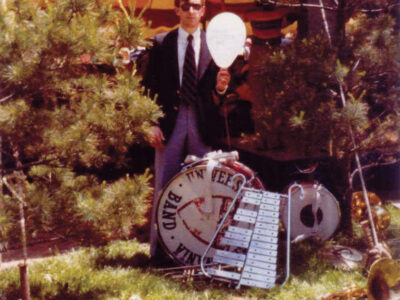
“We want to celebrate 125 years of achievement for women at Penn,” says Judith Roth Berkowitz CW’64. “To say, ‘How did women get to Penn, why did they come, what did they do while they were here, and what were the results? Was it worth it to go through all this aggravation to educate women?’ Because it certainly wasn’t easy. Nobody wanted to let them in, [but] once they got here, they did very well.”
Berkowitz, a Penn trustee, is the chair of the Celebration of 125 Years of Women at Penn scheduled for November 1-2, 2001, the Thursday and Friday before Homecoming. Planners hope to attract up to 2,000 alumnae back to campus for the Celebration, which will include a ceremony honoring women “firsts” at the University, a talk by NBC Chief Foreign Affairs Correspondent (and Penn trustee) Andrea Mitchell CW’67, panel discussions, a book signing and party for Penn women authors, and a networking reception, among other events.
In addition, a sculpture honoring women at Penn will be commissioned; and the existing Class of 1949 Bridge across 38th Street and its approach will receive a major refurbishing to create a Women’s Walkway and Generational Bridge recognizing Penn families. Also planned is a book that will combine photographs and essays on notable Penn women. Fundraising for the Celebration, with a goal of $3 million (of which $2 million has been raised so far), will also go to support an endowed scholarship, adds Berkowitz.
The anniversary marks the century and a quarter since the first women—Gertrude Klein Peirce and Anna Lockhart Flanigen—were admitted to a degree-granting program at the University, specifically the Towne Scientific School. “There were plenty of women at Penn before, but they were not in degree-granting programs,” explains Berkowitz. (Most were enrolled in non-degree courses similar to those administered today by the College of General Studies, or which led to a certificate rather than a degree, such as a three-year program in Interior Decoration.)
Though Berkowitz is the prime mover behind the 125th Celebration, she’s far from alone in putting it together. “We tapped into this chord, and when we started to see if people would be interested in this kind of endeavor, it turned out that they were very interested,” she says. Of 35 people invited to an initial meeting, 33 showed up. Since then, the group of core volunteers—members of the working committee—has swelled to more than 400, most of whom “really do have active roles.”
One especially well-placed alumna is Penn’s president, Dr. Judith Rodin CW’66. “Of course, it really does help to have a woman president at the University at the time when all this is going on—because she serves as the role model for everybody,” says Berkowitz. “She’s been a tremendous help to us in this whole project.”
With the assistance of the University’s Archives and Records Center, Celebration volunteers have been tracking down milestones for women at Penn—such as Dr. Rodin herself, Penn’s (and the Ivy League’s) first female president, and Sadie T.M. Alexander Ed’18 Gr’21 L’27, the first African-American woman to earn a doctorate at Penn and to graduate from the Law School. And the search is still on. “We’re trying to reach the first of everything,” says Berkowitz.
When she decided to become involved in heading the Penn celebration, Berkowitz recalls visiting the sculpture created by Maya Lin to mark 25 years of women being admitted to Yale University. “It’s beautiful, really quite beautiful —but to myself I was sort of saying, ‘25 years? We’re talking about 125 years.’ We offered an opportunity to women when opportunities didn’t exist.”
For Penn’s sculpture, which will be located near 34th and Walnut Streets, in front of either Hill House (originally a women’s dormitory) or Bennett Hall (once home to the College for Women), selected artists’ designs were submitted in April to a committee headed by Deborah Marrow CW’70 Gr’78, director of the Getty Grant Program at the Getty Center in Los Angeles, with a final decision expected before November.
The other major “physical change” the Celebration will bring will be at the 38th Street Bridge, “linking the old and new campuses,” says Berkowitz. A Women’s Walkway, with pavers honoring Penn women, will lead up to the bridge. On the bridge itself, more new pavers will be installed on which donors can inscribe their family’s Penn history. New lighting and plantings will also be added, improving the overall appearance of the structure—which, as Berkowitz delicately points out, “has never been beautiful.”
“We think that when you come to Penn with your children, this is the first place you’ll go—to the Generational Bridge,” she adds. “I don’t think anyone really knew what kinds of Penn-family traditions there really are. Women only go back a certain amount of time, but even among the women, their daughters come, their sisters come, children come.”
Berkowitz’s own Penn connections include her husband, Howard P. Berkowitz W’62 (they met as students), and her daughter, Sandra Berkowitz C’92. “My brother-in-law went, and his daughter went, and his first wife went. And my husband’s sister’s husband went,” she adds. “So we have quite a [number], but it’s more horizontal than vertical.”
Berkowitz recalls that she considered women’s colleges when she was applying to college—until she visited Penn. “I thought, ‘This is really the place I want to be.’” she says. Though it was still “rather unusual for women and men to be on campus together,” Berkowitz, who had gone to a coed high school, didn’t think anything of it. “The thing that did shock me was The Bennett News—that you couldn’t be on the staff of the DP. Women had their own newspaper.”
The Celebration project has revealed generational similarities and differences among Penn alumnae, reflecting the changing roles and views of women in higher education and the workplace. Recent graduates have been “very, very active,” in planning, Berkowitz says, adding: “We’re trying to reach out into the fifties, the forties, the thirties; we’re trying to go back as far as we can.”
While memories of discrimination may still smart for some older alumnae, for the women “who have come up to join us—we all know that there was a different standard back then —but we all had a wonderful opportunity,” says Berkowitz.
“I believe that the ones who have come forward to join in the project are the ones who took the opportunity and made something of it.”
Berkowitz’s mother had always worked, and she always assumed she would, too. She recalls graduating from Penn in 1964 “ready to get a job at IBM, and instead, I became a secretary at IBM. That was my reality check,” she says. “The sixties and seventies were definitely difficult. But it wasn’t because of what happened at Penn; it was because of what was happening all over.”
By the 1980s, women “were starting to be more aware of their place and be more secure of their place in the universe,” Berkowitz says. “The nineties women are there. They are there.” She describes these younger alumnae as “a breed apart. They are very self-confident, they are very assured.”
And they also—most of them, anyway—have an awareness of women’s history. Asked whether the notion of having a separate “celebration” of women seemed irrelevant to younger alumnae, Berkowitz replies: “We thought we might run into more of that” than has been the case. “The more introspective ones know that they’re where they are because others have done things to help them get there. And the others, who are not quite as introspective, understand that they’re there because they have a right to be there. And both of those points of view are correct. And we’re going to celebrate both.”
The 125th Celebration will kick off on November 1 with a book-signing and party at the Penn Bookstore in Sansom Common, where a poster featuring images of covers and spines from books by more than 200 Penn women authors will be displayed. Friday’s programs will include the formal opening of the Women’s Walkway and Generational Bridge, the ceremony honoring women “firsts,” and four panel sessions on women in medicine, business, politics and the media, and philanthropy. Scheduled participants include Andrea Mitchell, Ndidi Okonkwo W’95, executive director of the FATE Foundation, a private-sector-led initiative to assist wealth creation and entrepreneurship in Nigeria; Willow Bay C’85 of CNN, Jean Chatzky C’86, columnist for Money magazine and Today show regular; the photographer Mary Ellen Mark FA’62 ASC’64 Hon’94; Rebecca Matthias CW’75, president of Mothers Work, Inc.; Marcia Greenberger CW’67 L’70, president of the National Women’s Law Center; and Anne D’Harnoncourt Hon’88, director of the Philadelphia Museum of Art. The panels will be followed by a networking session for women.
“After that, many of us will be going to the Alumni Award of Merit dinner,” says Berkowitz. For those not attending the dinner, there will be “affinity tables” at some major restaurants in Philadelphia. The last scheduled event will be the annual Homecoming alumni run, within which women will do a special 2-mile walk, says Berkowitz.
But that won’t mark the conclusion of the 125th Celebration, she emphasizes. “We want to make sure that the celebration doesn’t just end. We want it to become how women associate themselves with the University in a major way.”




